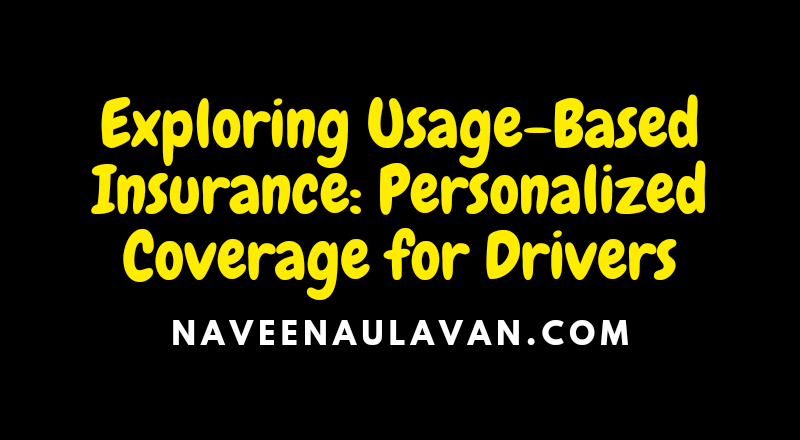In recent years, the insurance industry has seen a shift towards personalized and usage-based insurance policies. These policies utilize telematics technology to gather data on individual driving habits, allowing insurers to offer personalized coverage plans based on an individual’s risk profile. This article explores the concept of usage-based insurance and its benefits for both insurers and drivers.
Understanding Usage-Based Insurance
Usage-based insurance, also known as pay-as-you-drive or telematics insurance, is a type of auto insurance that calculates premiums based on an individual’s driving behavior. Instead of relying on traditional factors such as age, gender, and location, usage-based insurance policies assess risk by analyzing real-time data collected from a vehicle’s onboard telematics system. This data includes metrics such as speed, acceleration, braking, time of day, and distance driven.
The Benefits of Usage-Based Insurance
1. Personalized Premiums
One of the main advantages of usage-based insurance is the ability to tailor premiums to an individual’s driving habits. Traditional insurance policies often rely on general risk factors that may not accurately reflect an individual’s actual risk on the road. With usage-based insurance, premiums are based on real-time data, allowing for more accurate risk assessment. Safer drivers can enjoy lower premiums, while higher-risk drivers may be charged more in line with their risk profile.
2. Incentives for Safe Driving
By incorporating telematics technology, usage-based insurance policies incentivize safe driving behaviors. Drivers who know that their driving habits directly impact their premiums are more likely to adopt safer driving practices. This not only benefits the insured individual by reducing the risk of accidents but also contributes to overall road safety.
3. Fairness and Transparency
Usage-based insurance eliminates the perceived unfairness of traditional insurance policies, where everyone within a particular demographic pays the same premium regardless of their individual risk profiles. With usage-based insurance, premiums are based on how an individual actually drives, ensuring a fairer distribution of costs within the insured population.
4. Cost Savings Potential
For safe drivers, usage-based insurance can result in significant cost savings. By demonstrating responsible driving behaviors, individuals can maintain low premiums, which can be considerably lower than traditional fixed-rate policies. This cost-saving potential is particularly attractive for individuals who drive infrequently or for shorter distances as they will not be paying for coverage they do not require.
Types of Usage-Based Insurance
1. Pay-Per-Mile Insurance
Pay-per-mile insurance policies charge premiums based on the number of miles driven. These policies are particularly beneficial for individuals who drive infrequently or have low annual mileage. Insured individuals usually pay a base rate and an additional per-mile rate, allowing for accurate cost calculation based on actual usage.
2. Pay-How-You-Drive Insurance
Pay-how-you-drive insurance policies evaluate driving behavior and habits to determine the premium. Insurers collect data on metrics such as speed, acceleration, braking, and time of day to assess driving risk. This approach encourages individuals to adopt safer driving practices as it directly affects their premium rates.
3. Managed Mileage Programs
Managed mileage programs combine traditional fixed-rate insurance with usage-based insurance. These programs offer discounts to drivers who commit to driving within a specified mileage limit. By monitoring mileage and providing incentives for staying within the limit, insurers can offer reduced premiums to individuals who demonstrate responsible and limited driving practices.
Challenges and Considerations
While usage-based insurance offers numerous benefits, there are some challenges and considerations to keep in mind.
Data Privacy
The collection and use of personal data for usage-based insurance policies raise concerns about privacy. Insured individuals may be hesitant to share their driving data with insurers due to potential privacy breaches. Insurers must ensure robust data protection measures are in place to address these concerns and gain the trust of their customers.
Hardware and Telematics System Installation
Usage-based insurance policies require the installation of hardware and telematics systems in vehicles to collect driving data accurately. This installation process may be seen as an inconvenience to some individuals and could potentially limit the adoption of usage-based insurance if not made easily accessible and user-friendly.
Data Accuracy and Interpretation
For usage-based insurance to be effective, it is crucial to ensure accurate data collection and interpretation. Insurers must invest in reliable telematics technology and develop algorithms that can accurately analyze and interpret the collected data. Robust data analysis methods will ensure fair and accurate risk assessment for premiums.
User Acceptance and Adoption
The success of usage-based insurance depends on user acceptance and adoption. Insurers must educate potential policyholders about the benefits of usage-based insurance and address any concerns or misconceptions they may have. Offering incentives, such as lower premiums or discounts, can also encourage individuals to enroll in usage-based insurance programs.
Conclusion
Usage-based insurance is an innovative approach that revolutionizes the traditional auto insurance industry. By leveraging telematics technology, insurers can offer personalized coverage plans that accurately reflect an individual’s driving habits and risk profile. The benefits of usage-based insurance, including personalized premiums, incentives for safe driving, fairness, and cost savings potential, make it an appealing option for both insurers and drivers. However, challenges such as data privacy, hardware installation, data accuracy, and user adoption need to be addressed for widespread acceptance and implementation. With continued advancements in technology and increased awareness, usage-based insurance is poised to become the future of auto insurance, providing drivers with personalized coverage and promoting safer driving practices on the road.
